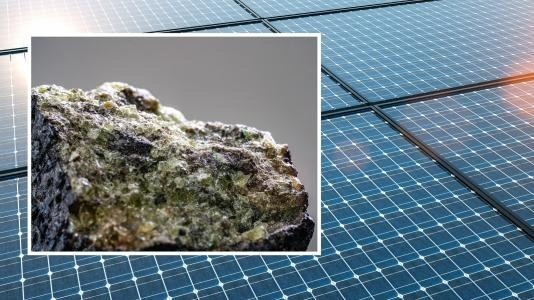A novel growth technique has been developed for hybrid perovskites that could have a huge impact on clean energy storage devices.

Researchers are looking at perovskites, shown here, a type of material that could have transformational potential in new generations of solar cells. Image Credit: by Shutterstock/Audio und werbung.
New materials that have the potential to both harvest and discharge light provide the stimulating ability for technologies that vary from solar cells to TV and display screens. In a new study performed, scientists have come up with a new method of improving the stability and performance of perovskites.
University of Missouri scientists, in partnership with researchers from the University of Western Cape in South Africa and physicists at the U.S. Department of Energy’s (DOE) Argonne National Laboratory, have engineered a new method to make hybrid perovskites.
These new materials are a combination of organic and inorganic semiconducting materials that could develop the foundation of new solar cells or other electronic devices.
Organic-inorganic hybrid perovskites have become increasingly attractive to the materials and electronics communities, especially over the past 10 years or so.
Suchismita (Suchi) Guha, Study Lead Author and MU Professor, Argonne National Laboratory
Guha added, “They have become, in some cases, as efficient as silicon-based solar cells. Additionally, they are also much more versatile than silicon and can be used and tuned for a broad array of applications.”
The techniques for making lead halide perovskites were enhanced by Guha and her collaborators. Earlier methods for making such thin-film perovskites need liquid processing with the help of solvents, thereby rendering the films vulnerable to degradation while being exposed to air.
Furthermore, with this prior manufacturing process, one of its molecules experiences a change to its structure, thereby limiting its performance in real-world operating conditions.
With the availability of a new method, it was possible for the scientists to avoid the change, thereby holding the impacted molecule in a stable structure across a large temperature range. The new technique also made the perovskite air-stable, thereby making it suitable for a potential solar cell.
There have been many studies that have looked at ways to try to improve the stability of hybrid perovskites, including diffusion barriers, additive engineering, and chemically inert electrode optimization, but this is one of the first studies to look at the growth method itself as a way to boost the final performance of the device.
Suchismita (Suchi) Guha, Study Lead Author and MU Professor, Argonne National Laboratory
To verify the molecular structure of the perovskite material, Guha and her collaborators, including Argonne physicist Evguenia (Jenia) Karapetrova, made use of X-ray diffraction measurements at Argonne’s Advanced Photon Source (APS), a DOE Office of Science user facility.
Karapetrova stated, “Being able to characterize the perovskite structure at the APS provides a unique window into the possibilities of this functional material.”
Preventing the phase change seems to be the key to ensure improved device performance. By maintaining a stable structure throughout the operating temperature window, we show the way to an improved and potentially useful perovskite.
Suchismita (Suchi) Guha, Study Lead Author and MU Professor, Argonne National Laboratory
Journal Reference:
Burns, R., et al. (2022) Temperature-Dependent Phase Stable Hybrid Halide Perovskite Films by Chemical Vapor Deposition. ACS Applied Electronic Materials. doi.org/10.1021/acsaelm.2c00449.